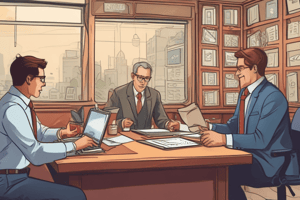Podcast
Questions and Answers
What is the first step to take when addressing an online complaint?
What is the first step to take when addressing an online complaint?
- Reaching out to the customer directly to discuss their concerns. (correct)
- Reporting the complaint to social media platforms.
- Posting a public response on the complaint thread.
- Ignoring the complaint to avoid escalating the situation.
What should be done after resolving a complaint?
What should be done after resolving a complaint?
- Ask the customer to publicly post their satisfaction.
- Inform the customer that their complaint was not valid.
- Request the customer to remove their complaint. (correct)
- Ignore the customer once the issue is resolved.
What do continual complaints indicate about a product or service?
What do continual complaints indicate about a product or service?
- They are isolated incidents that require individual attention.
- They are opportunities for improvement in products or services. (correct)
- They imply that no customers are satisfied with the product.
- They are always exaggerated and should be downplayed.
What is a core strategy for maintaining customer trust in the event of continual complaints?
What is a core strategy for maintaining customer trust in the event of continual complaints?
How should a business respond to complaints related to communication?
How should a business respond to complaints related to communication?
Why is it important to listen carefully to a customer's concerns?
Why is it important to listen carefully to a customer's concerns?
What action should be taken if a customer has a complaint that cannot be resolved immediately?
What action should be taken if a customer has a complaint that cannot be resolved immediately?
What can continual customer feedback help a business achieve?
What can continual customer feedback help a business achieve?
What should you do first when a customer complains about the wait time?
What should you do first when a customer complains about the wait time?
When experiencing delivery complaints, what should you do if the delay is caused by the mail carrier?
When experiencing delivery complaints, what should you do if the delay is caused by the mail carrier?
What is one suggested long-term solution for reducing wait times?
What is one suggested long-term solution for reducing wait times?
If a customer's complaint involves personnel, what is the first action you should take?
If a customer's complaint involves personnel, what is the first action you should take?
Why might a business experience delivery complaints?
Why might a business experience delivery complaints?
What should you do if the delay in delivery is caused by the business itself?
What should you do if the delay in delivery is caused by the business itself?
What is a proactive way to enhance customer satisfaction related to wait times?
What is a proactive way to enhance customer satisfaction related to wait times?
What should you do if you identify that a customer has a personnel complaint?
What should you do if you identify that a customer has a personnel complaint?
What factor significantly influences a consumer's likelihood to complain regarding a product or service?
What factor significantly influences a consumer's likelihood to complain regarding a product or service?
Which type of complaint involves customers expressing dissatisfaction due to long wait times?
Which type of complaint involves customers expressing dissatisfaction due to long wait times?
What is one potential outcome of negative word-of-mouth shared via social media?
What is one potential outcome of negative word-of-mouth shared via social media?
Which of the following is NOT a common type of customer complaint?
Which of the following is NOT a common type of customer complaint?
What should be done after documenting a customer's complaint about a product?
What should be done after documenting a customer's complaint about a product?
Which of the following increases the likelihood that a consumer will not complain?
Which of the following increases the likelihood that a consumer will not complain?
What is the primary reason customers most often complain?
What is the primary reason customers most often complain?
Which of the following actions can companies take to resolve a complaint about a broken product?
Which of the following actions can companies take to resolve a complaint about a broken product?
What is an effective way to demonstrate excellent customer service after a complaint is made?
What is an effective way to demonstrate excellent customer service after a complaint is made?
What is the primary goal of service recovery?
What is the primary goal of service recovery?
Why is it important to create a record of customer interactions?
Why is it important to create a record of customer interactions?
What should customer service teams be prepared with to handle complaints effectively?
What should customer service teams be prepared with to handle complaints effectively?
Which statement best describes service recovery?
Which statement best describes service recovery?
What can following up on customer complaints provide to the business?
What can following up on customer complaints provide to the business?
What is a common outcome of not addressing a customer complaint promptly?
What is a common outcome of not addressing a customer complaint promptly?
What type of feedback is commonly used to evaluate customer service experiences?
What type of feedback is commonly used to evaluate customer service experiences?
What is the primary objective of designing training and systems in customer service?
What is the primary objective of designing training and systems in customer service?
Why is it important for retailers to encourage customer complaints?
Why is it important for retailers to encourage customer complaints?
How should complaints ideally be resolved?
How should complaints ideally be resolved?
What aspect of customer treatment is emphasized in the content?
What aspect of customer treatment is emphasized in the content?
What is crucial for a retail organization to do after service failures?
What is crucial for a retail organization to do after service failures?
What can lead to customer switching behavior according to the content?
What can lead to customer switching behavior according to the content?
What is a suggested method for retailers to understand customer dissatisfaction?
What is a suggested method for retailers to understand customer dissatisfaction?
What approach should retailers take when facing service complaints?
What approach should retailers take when facing service complaints?
What is the primary goal of service recovery efforts?
What is the primary goal of service recovery efforts?
What can significantly damage a customer's confidence after a service failure?
What can significantly damage a customer's confidence after a service failure?
What is a common challenge employees face during service recovery?
What is a common challenge employees face during service recovery?
Which of the following situations may lead to a complete loss of customer confidence?
Which of the following situations may lead to a complete loss of customer confidence?
What defines the service recovery paradox (SRP)?
What defines the service recovery paradox (SRP)?
How should a firm respond to a customer complaint made after a service failure?
How should a firm respond to a customer complaint made after a service failure?
What effect can effective service recovery have on customer behavior?
What effect can effective service recovery have on customer behavior?
Which of these factors is NOT critical for effective service recovery?
Which of these factors is NOT critical for effective service recovery?
Flashcards
Customer Complaint Behavior (CCB)
Customer Complaint Behavior (CCB)
Actions by consumers that express their satisfaction or dissatisfaction with a product or service. This behavior can be influenced by factors like the perceived likelihood of success, exit barriers, alternatives, and the severity of the issue.
Perceived Likelihood of Success
Perceived Likelihood of Success
The belief a consumer has about whether they can get a fair resolution and be treated with respect when expressing a complaint.
Exit Barriers
Exit Barriers
Obstacles or barriers that prevent a consumer from switching to a different company or product.
Attractiveness of Alternatives
Attractiveness of Alternatives
Signup and view all the flashcards
Magnitude of Dissatisfaction
Magnitude of Dissatisfaction
Signup and view all the flashcards
Product or Service Complaint
Product or Service Complaint
Signup and view all the flashcards
Wait Time Complaint
Wait Time Complaint
Signup and view all the flashcards
Social Media Complaint
Social Media Complaint
Signup and view all the flashcards
Delivery Complaints
Delivery Complaints
Signup and view all the flashcards
Personnel Complaints
Personnel Complaints
Signup and view all the flashcards
Handling Wait Time Complaints
Handling Wait Time Complaints
Signup and view all the flashcards
Addressing Delivery Delays
Addressing Delivery Delays
Signup and view all the flashcards
Addressing Personnel Complaints
Addressing Personnel Complaints
Signup and view all the flashcards
Reducing Long Wait Times
Reducing Long Wait Times
Signup and view all the flashcards
Customer Incentives for Delays
Customer Incentives for Delays
Signup and view all the flashcards
Online Complaints
Online Complaints
Signup and view all the flashcards
Continual Complaints
Continual Complaints
Signup and view all the flashcards
Communication Complaints
Communication Complaints
Signup and view all the flashcards
Employee Training
Employee Training
Signup and view all the flashcards
Direct Communication
Direct Communication
Signup and view all the flashcards
Swift Complaint Resolution
Swift Complaint Resolution
Signup and view all the flashcards
Identifying the Root Cause
Identifying the Root Cause
Signup and view all the flashcards
Continual Improvement
Continual Improvement
Signup and view all the flashcards
Service Recovery
Service Recovery
Signup and view all the flashcards
Service Recovery Process
Service Recovery Process
Signup and view all the flashcards
Service Failure
Service Failure
Signup and view all the flashcards
Creating a Record
Creating a Record
Signup and view all the flashcards
Following Up
Following Up
Signup and view all the flashcards
Go-To Solutions
Go-To Solutions
Signup and view all the flashcards
Limitations
Limitations
Signup and view all the flashcards
Service Recovery Attempt
Service Recovery Attempt
Signup and view all the flashcards
Service Recovery Paradox
Service Recovery Paradox
Signup and view all the flashcards
Service Failure Impact
Service Failure Impact
Signup and view all the flashcards
Employee Limitations in Service Recovery
Employee Limitations in Service Recovery
Signup and view all the flashcards
Recovery After the Fact
Recovery After the Fact
Signup and view all the flashcards
Service Failure Prevention
Service Failure Prevention
Signup and view all the flashcards
Empathy in Service Recovery
Empathy in Service Recovery
Signup and view all the flashcards
Exceeding Customer Expectations
Exceeding Customer Expectations
Signup and view all the flashcards
Encourage complaints
Encourage complaints
Signup and view all the flashcards
Act quickly
Act quickly
Signup and view all the flashcards
Treat customers fairly
Treat customers fairly
Signup and view all the flashcards
Learn from recovery experiences
Learn from recovery experiences
Signup and view all the flashcards
Learn from lost customers
Learn from lost customers
Signup and view all the flashcards
Customer Database
Customer Database
Signup and view all the flashcards
High prices
High prices
Signup and view all the flashcards
Inconvenience
Inconvenience
Signup and view all the flashcards
Study Notes
Service Failures
- Service failures occur when consumers do not receive the promised services.
- Failures can happen in any organization, large or small.
- Examples include delayed delivery, incomplete service, rude employees, or failure to deliver the core benefit of the service.
- Not all dissatisfied consumers complain.
- Some spread negative word-of-mouth.
- Others may resort to legal action.
- Service recovery is crucial to satisfy consumers and encourage loyalty.
- Satisfied consumers are more likely to repurchase and recommend services to others.
Consumer Reactions to Service Failures
- Consumers may react in various ways to service failures.
- Some may complain directly to the service providers, which is considered an ideal situation for the service provider to respond.
- Spreading negative word-of-mouth about the service provider.
- Choosing not to patronize the service provider in the future.
- Expectations regarding apologies and follow-up.
Customer Complaining Behavior
- Customer complaint behavior (CCB) is a consumer's actions after negative service experiences.
- Factors influencing CCB include perceived likelihood of success, exit barriers, the attractiveness of alternatives, and the magnitude of dissatisfaction.
- Consumers may complain for reasons like poor customer service, such as slow or rude service.
- Social media can also be a platform for sharing negative word-of-mouth.
Types of Customer Complaints
- Product or service: Customers complain about broken products, or products not functioning as expected.
- Wait time: Complaints about excessively long hold times or waiting in lines.
- Delivery: Complaints about changes to expected delivery dates, or delivery issues by the carrier.
- Personnel: Complaints about negative interactions with employees.
- Online: Customers sharing feedback or complaints on online platforms or social media.
- Continual: When one or multiple customers express the same complaint.
Handling Customer Complaints
- Importance of carefully handling customer complaints to maintain customer loyalty and reputation.
- Important steps for handling customer complaints.
- Listen to the customer.
- Show empathy.
- Apologize.
- Ask thorough questions.
- Loop in necessary parties (e.g., colleagues)
- Find a swift solution.
- Follow up with customers about the complaint resolution
- Create a record of communications for future reference.
Service Recovery
- Service recovery is the actions taken to manage service failures and dissatisfaction.
- Companies aiming for zero-defect service, through training & organization structure, can reduce the need for service recovery.
- Importance of effective service recovery to maintain customer satisfaction, loyalty, and trust, especially when something goes wrong in the customer experience.
- Examples of service recovery strategies.
Service Recovery Paradox
- The service recovery paradox demonstrates that a company's positive response to a service failure can lead to higher customer satisfaction than if no failure had occurred.
- Customers who have experienced good recovery (following a service failure) tend to be more satisfied and loyal.
Studying That Suits You
Use AI to generate personalized quizzes and flashcards to suit your learning preferences.




